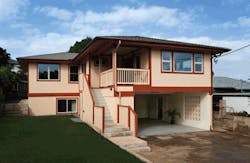KAILUA, HAWAII – When the Mattos family’s home in Oahu burned down due to an electrical fire, they decided almost immediately to rebuild. They turned to Bossert Builders in Kailua, a company that specializes in green and sustainable construction. The Mattos told them they liked the idea of building green, but all the money they had to spend was from the insurance settlement. In other words, could Bossert build a green home for the price of a standard home?
The answer was a resounding “yes,” and the result was Hawaii’s first National Association of Home Builders green-certified home. Bossert Builders has been in operation six years, serving all of the island of Oahu. It’s run by the husband-and-wife team of Nick (the CEO) and Leanne (the President) Bossert. Nick has been a licensed General Contractor since he was 23, and involved in building custom and luxury homes since he was 13. Leanne has a Masters in Organizational and Intercultural Communication from the University of Hawaii, undergraduate studies in business, marketing and architecture, and is also a Realtor Associate.
Oddly enough, eco-friendly, high-efficiency and sustainable building practices are not very common in the Aloha State. Energy prices on the islands are some of the highest in the nation, but very few homebuilders are trying to sell their customers on the long-term savings green choices can produce.
“We’re trying to make a make a name for ourselves in the industry,” Leanne said, “and we’re trying to promote the techniques and technology so more Hawaii homebuilders will go green.”
Construction lasted from August 30 through January 30. Bossert subcontracted various parts of the project, notably Precision Plumbing for the plumbing and piping, and EnergyPro Hawaii for the solar systems.
The first phase of the project was demolishing the burnt-out remains of the old home. Performing a careful, selective demolition was key because preserving the original foundations would save the Mattos from $100,000 to $150,000.
Describing the work of maneuvering a 20,000-ton excavator on a small lot, Nick said, “It’s not very easy. But we took our time and got the job done right so we could get on with the rest of the house.”
The Mattos’ new home features solar thermal collectors on the roof hooked to a Heliodyne Helio-Flo heat-transfer appliance for the building’s hot water needs. The compact appliance is mounted to a 120-gal. storage tank.
“They haven’t had a day — even in an overcast day — without hot water,” Nick said.
The home has electric water heating backup, in case of an extended overcast period in the tropical climate. The house also uses rainwater collected from the roof to water the landscaping. Rainwater is stored in two Water Hog, 50-gal., above-ground catchments.
All faucets, fixtures and toilets are low-flow and high-efficiency. Brands include Price Pfister, Kohler and Glacier Bay, most of them obtained from the local big-box stores, rather than through any special ordering.
Leanne described her search for green fixtures as, “A learning experience in itself. We tried to find everything on-island – and a lot of it was readily available.”
The new home does not include an AC system, which many would consider a must-have considering the climate. Instead, ceiling fans, UV-reflective solar shingles, ventilation and insulation all combine to keep the home cool and its occupants comfortable. Other green construction materials include man-made lumber, and Brazilian Cherry and Tiger Wood (a type of bamboo) laminates for the flooring.
The National Association of Home Builders inspected the results through their National Green Building Certification Program and gave the building a Bronze rating. The program is an ISO-accredited, third-party inspection agency and building product testing laboratory. Among the criteria they use are energy efficiency, water efficiency, resource efficiency, lot and site development and indoor environmental quality.
“The owners are still in the process of getting everything moved back in,” Nick said, “but they’re happy with their home. They’ve told us that anytime we want we can bring new or future clients through the house to take a look.”
“Every time we get a new client now,” Leanne said, “we offer them green home options.”
Related Articles:
Will home buyers pay for green features?
Related Articles:
Homebuilders applaud ANSI approval of green standard
About the Author
Steve Spaulding
Editor-in-Chief - CONTRACTOR
Steve Spaulding is Editor-in-Chief for CONTRACTOR Magazine. He has been with the magazine since 1996, and has contributed to Radiant Living, NATE Magazine, and other Endeavor Media properties.
